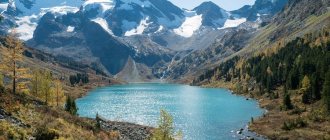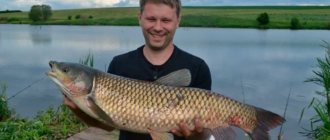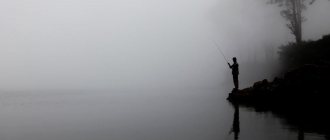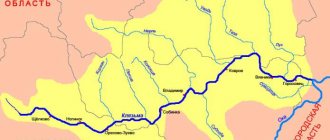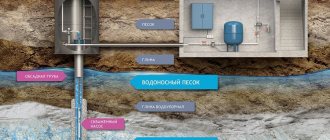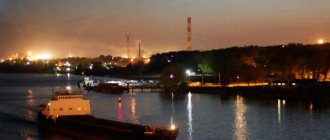The Svir River in the guidebook “Leningrad - Astrakhan - Rostov-on-Don” (1968)
Map of the Svir River from the guidebook “River Cruises (2002)”
Map of the Svir River from the guidebook “Leningrad - Astrakhan - Rostov-on-Don (1968)”
The Svir is a river in the north-west of the Leningrad region, connecting two great lakes - Onega, from which it flows, and Ladoga, into which the river flows. Previously, Svir was one of the links of the Mariinsky system built in 1810, and currently it is an important part of the Volga-Baltic route. The river is the route of cruises of many tourist ships heading to St. Petersburg and Kizhi.
The river and its surroundings are famous for their beauty and rich natural world. The water in Svir is so clean and transparent that the sky and forest in the rays of the sun are reflected in it, like in a mirror, and the clouds seem to be swimming in the river.
Poets glorify the river, calling it fabulous and shining, beautiful and wonderfully glowing. The poet Sergei Pronin writes about the diversity of the Svir:
Sparks sparkle in the waves, But the Svir can be different: From hanging clouds - gray, From crimson dawns - red, It can be dark blue, It can be dark pink, It flows through Russia, Alder and birch, It flows, rustles with breakers, Sometimes quiet, sometimes stormy , Steel, blue, But I love any!
Also, many poems have been written about Svir, dedicated to the heroes who died in these places during the Great Patriotic War, and to the builders of the hydroelectric power station.
Source of the Svir
The river originates in Lake Onega and flows from east to southwest. Its source is located near the village of Voznesenye, which appeared in the first half of the 19th century. Here, goods arriving via Lake Onega or along the Onega bypass canal were reloaded from lake ships to river ships.
Ascension is located at the crossroads of the White Sea-Baltic and Volga-Baltic routes. There is a meteorological station in the village, which, depending on weather conditions, prohibits or allows ships to enter Lake Onega.
The river bed can be divided into three sections:
- Upper Svir 95 km long
- Middle Svir with a length of 45 km
- Nizhnyaya Svir is 80 km long.
Settlements on the Svir River
The first settlers on Svir were the Vepsians. In the 10th century there was a lively trade along the river. The Svir River was part of the ancient Volga-Nevsky waterway. The numerous treasures with foreign coins found here testify to the trade industry on Svir.
In the 13th century, the river became part of the Novgorod lands. The role of Svir as a transport artery increased significantly after the construction of St. Petersburg. At the beginning of the 18th century, a village was founded on the river at the Olonetsky shipyard, which later became the city of Lodeynoye Pole.
At the beginning of the 19th century, the Svir became part of the Mariinsky water system; after reconstruction in the 20th century, the river became an important artery in the Volga-Baltic waterway.
There are 2 hydroelectric complexes on the Svir - Nizhnesvirsky and Verkhnesvirsky, which divide the river into 3 different sections: Lower Svir 80 kilometers long, Middle Svir - 45 kilometers and Upper Svir - 95 kilometers. The reservoir of the Verkhnesvirskaya hydroelectric power station formed the “Ivinsky Razliv” with an area of 183 km².
There are 25 settlements on the Svir River, including 2 cities - Podporozhye, Lodeynoye Pole and the urban village of Voznesenye.
Verkhne-Svirskoye Reservoir - Ivinsky Razliv
The Verkhne-Svirsky hydroelectric complex was launched in 1952, it includes an earthen and spillway dam, a hydroelectric power station building and a single-stage single-thread lock, the useful dimensions of which are 17.8 by 270 meters.
After the construction of dams in the upper reaches of the river from the village of Voznesenye almost to the village of Plotichno, the Verkhne-Svirskoye Reservoir, or Ivinsky Razliv, was formed. The length of the reservoir is 43 km, and the width of individual sections reaches 24 km.
During the construction of the dam, all settlements, from Ascension to Podporozhye, were moved away from the shore, as they fell into the flood zone. Dozens of villages and all the temples located along the banks disappeared. One of the flooded settlements was Ostrechina, in the center of which was the village of Vorobyovo. Now this village is gone, and in the middle of the flooded area stands an island - the remains of a church. Now a modern cross has been installed on the island, around which the surviving tombstones of the church cemetery are collected.
Nine rivers flow into the Verkhne-Svirskoye Reservoir, including Ostrechinka and Ivina, Rzhanoi and Selga. The banks are covered with dense coniferous and deciduous forests, and sometimes there are meadows.
Ducks nest on large and small islands, and there is a lot of fish in numerous creeks. The forests are rich in berries and mushrooms, they are home to black grouse and wood grouse, hazel grouse and squirrels, hares and bears.
Through the gateway of the Verkhne-Svirsky hydroelectric complex, the ship descends 14.5 meters and enters the middle Svir, where the city of Podporozhye and the Vepsian Forest nature reserve are located.
The Vepsian Forest is a national park with many rivers, lakes and springs, the water in which seems to be crystal. There are untouched areas of forest with a variety of flora and fauna. This is the region where the Vepsians live - a people with a distinctive culture, their own language and traditions.
Economic use
The Nizhne- and Verkhnesvirsky hydroelectric complexes are located here. The reservoir of the latter is expressed by the Ivinsky Razliv/Verkhnesvirsky Reservoir, its area is about 185 km². The Lower Svir is considered to be the area in the Ladoga Lowland area and further downstream. The flowing Pasha and Oyat form a delta with numerous tributaries and branches connected to Guba Zagubskaya. The Nizhnesvirsky nature reserve is located there. In total there are about 30 islands. The banks of the river are covered with dense coniferous and deciduous forests, sometimes interspersed with meadows.
Verkhniye Mandrogi
Downstream is the amazing and unusual village of Verkhniye Mandrogi, which houses an open-air museum of modern wooden architecture created by woodcarver Yuri Ilyich Gusev.
Mandrogi translated from the Vepsian language means Thresholds. Previously, the local rocky shores did not allow boats to pass through, and then cargo was unloaded onto the shore and carried along with the boat in their arms or dragged.
Currently, a tourist center has been created in Verkhniye Mandrogi, where guests can visit a pottery and printing workshop, a forge, a painting workshop and the Vodka Museum. Master classes, horse riding, trips to the shooting range and shooting from hunting rifles under the guidance of an experienced instructor are organized.
For owners of yachts and boats there is guest parking at the piers. Those who wish will be able to take a steam bath in a Russian bath and taste traditional Russian cuisine.
Geographical information
It is 224 km long, originates in Lake Onega and flows into Lake Ladoga. The width of the river along its entire length varies from 100 m in narrow places of the channel to 10-12 km in the Ivinsky Razliv. The current speed varies from 0.5 to 10.6 km/h. Average water flow is 785 m³/s. The height of the mouth is 4.84 m above sea level.
Before the appearance of Svir, the flow from Lake Onega to Ladoga occurred to the south - through the Oshta - Tuksha - Oyat rivers. The modern river arose about 9.5 thousand years ago as a result of transgression of the southern part of Lake Onega, caused by the isostatic uplift of the northern part of the lake basin. As the river bed was cut, the level of Lake Onega dropped from 75 meters above sea level to the current 33.
The river flows in lowlands that in the past were occupied by glacial reservoirs. The Svir coast is mostly a forested hilly area. There were rapids in the middle reaches of the Svir, but after the construction of a cascade of power plants on the river, dams raised the water level, flooding the rapids and creating a deep-water path along the entire length of the river. On the river there are Nizhnesvirsky (80 km from the mouth) and Verkhnesvirsky (120 km from the mouth) hydroelectric complexes. The reservoir of the Verkhnesvirskaya hydroelectric power station formed the Ivinsky Razliv or Verkhnesvirskoye Reservoir with an area of 183 km².
The Lower Svir flows within the Ladoga Lowland and downstream from the confluence of the Oyat and Pasha rivers into it, it forms a delta with many branches and channels, one of which connects with the Zagubskaya Guba. The Nizhnesvirsky Nature Reserve is located here. In total there are about thirty islands on the river.
The largest island is Ivankoostrov.
Nizhne-Svirskoye Reservoir
In 1927, under the leadership of academician Heinrich Graftio, the construction of the Nizhne-Svirsky hydroelectric complex began. More than 15 thousand people took part in its construction, and most of the work was carried out manually.
In the summer of 1933, ships sailed through the built lock, and in 1935 the hydroelectric power station was fully operational. The lock of the Nizhne-Svirsky hydroelectric complex will raise and lower motor ships by 12 meters, its length is 200 meters, width - 20 meters.
During the Great Patriotic War, German troops captured the waterworks, and on the eve of the Soviet offensive, the occupiers blew up the gates of the lock. The waterworks was restored at the end of the war, also under the leadership of Academician Graftio.
Svirstroy
During the construction of the hydroelectric complex, the village of Svirstroy was built; about 30 thousand people lived there, the builders of the hydroelectric power station, including many prisoners. Now Svirstroy is an urban village with a population of about 1000 people.
A monument to Academician Graftio was erected in front of the hydroelectric power station; his name was given to the Nizhne-Svirsky hydroelectric complex. Also in the village you can see a monument to Kirov, who visited the hydroelectric complex under construction in 1927. Next to the pier there is a small market where souvenirs are sold.
In summer, you can swim in a small bay located a 5-minute walk from the pier. There is a sandy beach here, and the water is much warmer than in the river itself.
Tourists can also visit two shrines of the Russian North - the Trinity Alexander-Svirsky Monastery and the Vvedeno Oyatsky Convent.
Svir
The fast and cold Svir flows from Lake Onega and flows into Lake Ladoga. The length of the river is 220 km, the width varies from 100 m in the area of Podporozhye to 10-12 km in Ivinsky Razliv. Svir is high-water and carries 82 percent of the water lost by Lake Onega. On the way to Ladoga, the river also absorbs the waters of tributaries - the Ivina, Vazhina, Pidma, Oyat, Pasha and many other rivers and streams. There are rocky hazards in many places on the Svir River, and therefore, running a vessel aground while sailing along the Svir entails damage to the hull. At the mouth of the Svir, the average annual water flow is 790 m3/s. Two hydroelectric complexes were built on the river - Nizhnesvirsky and Verkhnesvirsky, which divide the river into three sections characteristic of the channel and water regime: Lower Svir with a length of 80 km, Middle Svir with a length of 45 km and Upper Svir with a length of 95 km. At the mouth of the Svir and at its source, the water level depends on the level in lakes Ladoga and Onega. and from surge winds. Svir is characterized by significant daily fluctuations in the level in the lower reaches of hydroelectric facilities associated with the operating mode of the hydroelectric power station. During the day, the water level in the pools can change by up to 3 m. The influence of duck fluctuations extends 40 km down from the Nizhnesvirsky hydroelectric complex and 20-25 km below the Verkhnesvirsky hydroelectric complex. The river flows through a hilly plain covered with dense pine forest, the banks are very beautiful. Not far from the Nizhne-Svirsky hydroelectric complex there is the village of Svirstroy - a green parking lot (despite the “industrial” name, the place is beautiful and quiet). The largest city on the Svir is Lodeynoye Pole. When staying in Svirstroy, an additional excursion to the Alexander-Svirsky Monastery, 25 km away, is sometimes offered. from Lodeynoye Pole. At the mouth of the Svir River, where it flows into Ladoga, the State Nizhnesvirsky Nature Reserve is located on numerous islands and channels.
Waterways
| And the Sea of Azov Amur | B Belaya White Sea White Lake White Sea-Baltic Canal | V Vetluga Volga Volga-Baltic Canal Volga-Don Canal Volgograd Reservoir Volkhov Votkinsk Reservoir Vytegra Vyatka | Gorky Reservoir | D Dnepr Don |
| E Yenisei | And Ivankovskoe reservoir Irtysh | K Kazanka Kama Kama Reservoir Moscow Canal Caspian Sea Klyazma Kovzha Kuibyshev Reservoir | L Lake Ladoga Lena | M Mologa Moscow |
| N Neva | O Ob Oka Lake Onega | R Rybinsk Reservoir | C Saratov reservoir Svir Northern Dvina Northern Dvina water system Sura Sukhona | T Taganrog Bay |
| At the Uglich Reservoir | Central Tsimlyansk Reservoir | Ch Cheboksary Reservoir Black Sea Chusovaya | Sh Sheksna |
Trinity Alexander-Svirsky Monastery
The Trinity Alexander-Svirsky Monastery is located in a picturesque location on the high shore of Lake Roshchinskoye, 30 km northwest of the village of Svirstroy, in the village of Staraya Sloboda. The monastery was founded in 1484 and consists of two closely located monasteries - Trinity and Preobrazhensky.
- In the center of the Trinity Monastery rise the stone Trinity Cathedral, built in 1695, the Intercession Church of the first half of the 17th century with a 2-story refectory and a 3-tiered belfry.
- In the Transfiguration Monastery there is a stone Transfiguration Cathedral, created in 1644, and cells built in the second half of the 17th century.
In the monastery you can venerate the incorruptible relics of St. Alexander of Svirsky, which, according to legend, have healing powers, as well as drink water from the holy spring and take sand from the place where the Holy Trinity appeared to the saint.
Introduced Oyat Convent
Introduced The Oyatsky convent was first mentioned in the chronicle of 1448; it is the oldest monastery in the Lodeynopolsky district of the Leningrad region, located near the mouth of the Svir tributary of the Oyat River, the length of which is greater than the Svir itself.
The three-tier bell tower of the monastery, created in the late classicist style, was erected much later - in 1857–1859. During the restoration, its spire was replaced with an ancient Russian tent.
In the village of Mandera, located on the other bank of the Oyat River, the wonderworker Saint Alexander of Svir was born.
The monastery was revived in 1992. A chapel was built next to it, inside which flows a holy spring, famous for its miracles. Its healing water tastes like Narzan mineral water. A warm winter bath was built on the pond of the monastery, where you can wash yourself with holy water from the source at any time of the year.
The monastery contains the relics of Saints Reverend Sergius and Varvara, parents of Saint Alexander of Svirsky.
Fishing on the river
3
You can fish on the Svir River in different ways, but the most popular are spinning and donka. Some anglers prefer the float direction. In winter, they mainly use rigs and rigs, as well as heavy jigs or bottom rigs.
It is worth noting the peculiarities of catching salmon species. Their fishing is permitted in the following areas:
- From the mouth to the Nizhesvirskaya hydroelectric station, using bottom and float fishing rods without restrictions. It is prohibited to fish with spinning rods from May 15 to June 15, and from October 1 to November 30.
- Above the dam of the Nizhesvirsky hydroelectric complex, there are no more than 10 hooks per fisherman for a float and a donk all year round. You can fish with spinning rods from May 20 until the start of the spawning ban.
- From the mouth to the village of Alekhovshchiny, use a float rod with a maximum of five hooks per person.
The main methods of catching predatory fish on the Svir River are spinning fishing methods and bottom live bait gear. Of the artificial baits, the best results are shown by silicone and oscillating spoons; you can also use front-loaded spinners and deep-sea wobblers.
In winter, girders can be placed in calm sections of the river
Peaceful fish are caught with donks and float rods. Among the first popular ones are banal snacks, rubber bands, and weights. Experienced fishermen use feeder gear. The best baits on the Svir are a bunch of bloodworms, a red worm and maggots.
Lodeynoye Pole
The birth of this city is associated with the name of Peter the Great, who created the Russian fleet. At the beginning of the 18th century, Russia was in dire need of sea vessels to wage the Northern War. Here, on Svir, there were all the conditions for creating a shipyard - a deep river, an abundance of slender mast-bearing pines and carpenters famous for their skill.
Construction of the Olonets shipyard began in 1702 by decree of Peter the Great under the leadership of Prince Alexander Menshikov. On August 22, 1703, the first ship of the Baltic Fleet, the 28-gun frigate Shtandart, was launched.
The ships at the Olonets shipyard were built until 1829 and all of them distinguished themselves in the battles in which the Russian Empire participated during the Northern War. Many ships carried out round-the-world sea expeditions.
On the three-masted sailing sloop "Diana" Vasily Golovnin made his famous voyage from Kronstadt to Kamchatka, and the sloop "Mirny" under the command of Mikhail Lazarev took part in the first Antarctic expedition.
Not far from Lodeynoye Pole, a drawbridge was built, along which a railway line, two lanes for cars and a pedestrian path were laid.
Sviritsa
In the river delta, six kilometers from its mouth, is the village of Sviritsa, the history of which began in the 13th–14th centuries, when a trading post of Veliky Novgorod was created here. In the 18th century, on the instructions of Peter the Great, Alexander Menshikov came here to build a military harbor. But the place was considered unsuitable for these purposes.
The village of Sviritsa is located on seven islands and numerous dams protect it from the storms of Lake Ladoga and spring river floods.
There are weather stations here, according to which information ships are allowed or prohibited from entering the Ladoga Sea.
Nizhne-Svirsky Nature Reserve
The Nizhne-Svirsky State Nature Reserve, located in a picturesque place on the right bank of the Svir, was formed in 1980, its area is 42,390 hectares, and the landscape is represented by pine, spruce and birch forests, as well as vast swamp areas, numerous lakes and rivers.
The flora and fauna of the reserve are rich and diverse. Here you can find elk and bear, wild boar and wolf, beaver and badger, mink and fox, pine marten and many other animals. The reserve is home to 262 species of birds, and 33 species of fish are found in the reservoirs.
The territory of the reserve is classified as wetlands of international importance. The spring and autumn migration routes of birds pass here and their traditional stopover along the flight path is located.
Storozhensky lighthouse
Storozhensky lighthouse is one of the tallest in Europe, its height is 72 meters. Previously, when there was no lighthouse, there lived a watchman on the cape who helped Novgorod merchants find their way to the mouth of the Svir. Currently, the lighthouse helps to bypass the Storozhensky Reef, which stretches from Cape Storozhensky to Torpakov Island in the north.
There is a legend according to which in the 16th century, robbers lived on Cape Storozhensky, robbing ships that sailed along Lake Ladoga to the mouth of the Svir. But one day they found themselves in a strong storm, during which they made a vow that if they were saved, they would build a monastery. As promised, they built the St. Nicholas Monastery, which existed here for almost two centuries.
The red light of the Storozhensky lighthouse indicates to ships that they cannot go directly west, but must turn north and go around the white buoy marking the Torpakovsky reefs, which are also called the Sovereign Shoal.
According to legend, when there were still many shallows in this area, Tsar Peter the Great himself sat down on one of them. This shoal was named Gosudareva. Currently, the fairway is deepened and ships do not have to worry about running aground.
Fishing on the Svir
The banks of the river in many places are indented with large and small, shallow and deep creeks, rich in fish, and Svir is simply a paradise for fishermen: salmon and bream, grayling and pike, ide and pike perch, roach and catfish, burbot and many other species of fish are found here.
At the same time, with the construction of dams, the biological conditions for their life changed, especially in the area between the Podporozhskaya and Svirstroy dams. This part of the river resembles a huge aquarium, in which there is not much room for fish. In addition, the frequently and sharply changing water level associated with the operation of the sluices is also unfavorable for their life.
Despite all these negative consequences of dam construction, an experienced fisherman here will never be left without fish.
Spawning prohibitions for fishing on the Svir
Along the entire length of the Svir River, fishing is permitted with all fishing gear, except for those prohibited by fishing rules.
There are some restrictions on fishing on the Svir River.
Fishing for whitefish is prohibited throughout the entire water basin.
You can fish near populated areas. There are also certain catch restrictions. They are shown in the table below.
| What is possible | What not to do |
| Salmonidae | |
| The catch was 500 meters from the end of the restricted zone of the Nizhne-Svirskaya hydroelectric power station. You can use donka or floats as gear | Spinning fishing is prohibited from 01.10 to 30.11 and from 15.05 to 15.06. No more than 5 units per person |
| Burbot | |
| Everywhere except the 500-meter zone near dams and bridges | Ice fishing is permitted, but subject to the use of no more than two single-neck meshes (2 meters, with a hoop diameter of 50 centimeters) |
You can fish from the shore, or you can use a swimming device. Naturally, the second method is preferable, since the probability of getting a good catch increases several times.
Shipping
One of the eastern branches of the route “from the Varangians to the Greeks” once passed along the Svir, but then the river was shallow, with rocky rapids and sandy rifts. For the passage of ships, haulage was often used here, and then horse-drawn. The entire route, from the source to the mouth of the river, was divided into sections that were serviced by residents of coastal villages.
With the construction of dams, the Svir became a full-flowing and powerful river, navigable along its entire length. The river freezes at the end of December and opens in April, so that the navigation period lasts several months.
Many people believe that the Svir is the most beautiful river in northwestern Russia. She may be different, but she is always amazingly beautiful. The river fascinates with its endless reflections in the clear water. And how can one not remember the words of the poet Pyotr Ivanyuk: “On a white night, the turquoise water glows wonderfully, whoever meets Svir at least once will fall in love forever.”
Svir River
The Svir is the third (after the Neva and Volkhov) most famous river in North-West Russia.
But, if the Neva and Svir “participate” in cruises from St. Petersburg, then Volkhov is deprived of this opportunity due to the shallow waters and low demand for the route.
All cruises to Kizhi go through it, and almost halfway through, tours to the village of Mandrogi end.
The Svir originates in Lake Onega (where Kizhi is located), and flows into Ladoga, where from its mouth to Valaam there are 134 kilometers in a straight line.
In pre-Petrine times, the river was not an important trade and transport artery, but with the beginning of the Northern War its role increased many times over.
One of the famous and important settlements of that era was the village of Resurrection. It stands near its very source, where the river flows from Lake Onega.
This beautiful name was given by the Ascension Monastery, built in the 15th century and lasting 300 years.
Not far from the monastery, near the Ascension threshold, there was a small fishing village called Svirskoe Ustye.
When the Mariinskaya canal system was opened in 1810, the village grew into the large village of Voznesenye, which served as an intermediate pier and trading center.
Large cargo ships arrived here from the lake, goods from which were redistributed to smaller ones, which already transported them to coastal cities.
A huge number of piers and unloading areas, whole rows of barns and warehouses were built on both banks.
As shipping developed, ship repair yards began to be built by the end of the 19th century. By the beginning of the Civil War, the village, then called Namoinye Sands, was capable of receiving an entire division of patrol ships, as well as ensuring their technical condition was checked and repaired.
Nowadays, the village of Voznesenye can no longer be called such a large and important port. However, the repair base and timber industry enterprise are still located here, at the mouth of the Svir River.
There is also a ferry crossing here, and city buildings are already visible on the left bank.
What is surprising (more precisely, it reflects the strange metamorphoses of the early Soviet “cutting up” of the country into parts), the village and the small coastline of Lake Onega belong to the Leningrad region, although neither from the point of view of economics nor geography this makes any sense.
When the construction of the dam and the Verkhne-Svirsky reservoir began, large and small villages, from Ascension to Podporozhye, were moved away from the shore, as they fell into the flood zone.
Only those located on the top of the rocky mountain ridge remained untouched.
Passing the village of Krasny Bor, the waters of the Svir are divided into several branches that go around small islands.
The largest, 5 kilometers long, is called Ivankoostrov. Motor ships go around the island on the left side, passing by rocky shores.
Further, expanding, the river goes around the island of Vyazostrov on both sides, beyond which its waters again merge into one stream.
Beyond Vyazoostrov, the Svir narrows greatly, forming a “throat”, in order to then get out into the open spaces of the Ivensky Razliv.
Previously, this place was a lake, the basin of which was formed during the Ice Age.
Further, the river, noticeably narrowing, flows almost in a straight line.
On the right bank of the Svir in this place there is the Rivne quarry, in which dark red quartzite is mined.
Then the river turns sharply to the southwest and again runs almost in a straight line, past the village of Plotichno, famous for its ancient forestry industry.
